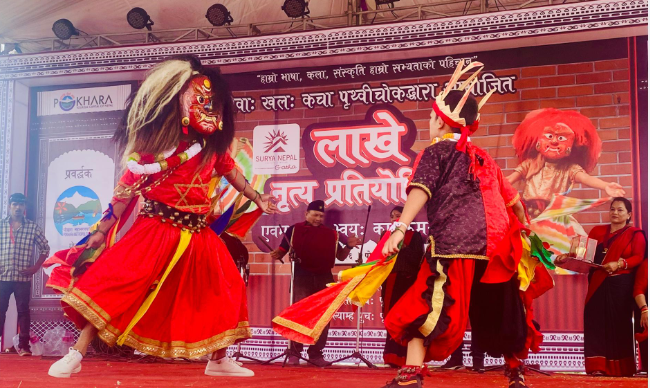The Newar community in Baglung continues to uphold ancient festivals and traditions, with a vibrant display of cultural heritage during the Bhadrayre Jatra. This annual festival, which kicks off the day after Janai Purnima, marks the beginning of a series of cultural events and dances that precede major celebrations. One of the highlights is the popular Lakhe dance, which traditionally starts during the Ganta Karna festival.
On August 10, the Lakhe dance showcased the cultural richness of Pokhara, with the “Newar Khala Kacha Prithvichok” organizing a lively Lakhe dance competition. The event saw participation from 20 artist groups, with three groups performing out of competition. Held at the Pokhara Exhibition Center, the event attracted art enthusiasts who not only enjoyed the performances but also savored traditional Newar dishes.
The competition featured various dance groups, with the top performers receiving cash prizes: Mohria Singh Nath Tole Taiya Machha Committee won NPR 55,555, Ram Krishna Tole Lham Pucha received NPR 33,333, Samaj Kalyan Newar Khala Raja Ko Chautara secured NPR 22,222, and Graihapatan Newar Samaj received a consolation prize of NPR 11,111. The event was organized by Surendra Prasad Shrestha to preserve and transmit the Lakhe dance tradition.
The Lakhe dance, which begins during the Ganta Karna festival and concludes at Teej, symbolizes the legend of the demon Ganta Karna and his defeat by soldiers, with his widow dancing as Lakhe. This tradition is maintained by the Newar community with variations depending on the region.
In Baglung, the Bhadrayre Jatra has commenced, with performances scheduled from Janai Purnima to Krishna Ashtami. The festival features a range of dances and displays, including Lakhe, Bassa, Ropai, Howa, Jogi, and Katwal. These performances, including the Gai Jatra, are conducted in memory of deceased relatives, with Bassa and Taiyamcha dances displaying mythological stories and divine roles.
Newar communities in Baglung, led by Nepal Bhasa Manka Khala and Shakya Kalyan Samaj, are actively preserving these traditions. Shakya Kalyan Samaj continues to organize Lakhe and Jogi dances, while other performances are safeguarded by Nepal Bhasa Manka Khala. The Newar youth organization Newar Lham Pucha also plays a crucial role in the preservation of these cultural practices.
The Bhadrayre Jatra, which dates back nearly 400 years, was introduced to Baglung by Newars from Bhaktapur, Dhulikhel, and Bhaktapur. Cultural expert Prem Chhotal explained that the festival serves as a medium for community bonding, social messages, and entertainment, with various traditional songs and dances performed during the event.
Despite the decline in traditional festivities, efforts are being made to keep these cultural practices alive. In areas with Newar communities, including Harichaur, Hattiya, and Balewal, the Barka Nach (monsoon dance) is still performed. However, some traditional dances face challenges due to a lack of preservation and increasing emigration among the youth. There is a pressing need to pass on cultural knowledge and skills to the younger generation to ensure the survival of these traditions.
In Myagdi’s Beni Bazaar, the Bharka Nach starts from the Ganta Karna festival on Shukla Chaturdashi, with performances of Lakhe, Naga-Nagini, Ghoda Nach, and Krishna Ratha Yatra. Newar community leaders emphasize the need to maintain cultural connections despite modern challenges and reduced interest among the younger generation.
While traditional dances and festivals face modern-day challenges, the Newar community in various districts, including Pokhara, Tanahun, Bandipur, and Parbat, remains dedicated to preserving their rich cultural heritage amid evolving societal dynamics.






